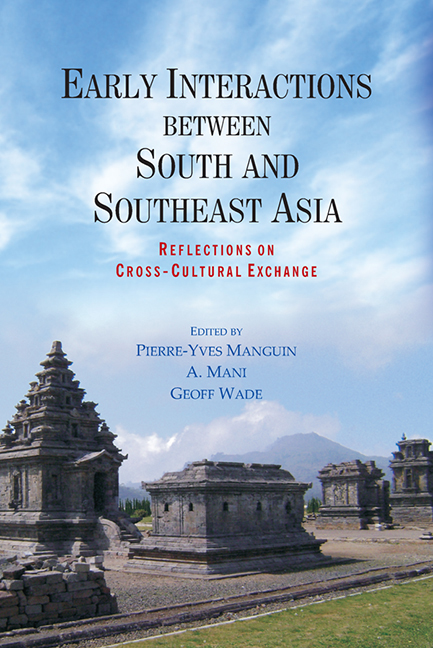Book contents
- Frontmatter
- Contents
- FOREWORD
- Preface
- Introduction
- PART I New Archaeological Evidence from South Asia and Southeast Asia
- 1 Central Vietnam during the Period from 500 BCE to CE 500
- 2 Ban Don Ta Phet and Khao Sam Kaeo: The Earliest Indian Contacts Re-assessed
- 3 Preliminary Study of Indian and Indian Style Wares from Khao Sam Kaeo (Chumphon, Peninsular Thailand), Fourth-Second Centuries BCE
- 4 Early Contacts between India and the Andaman Coast in Thailand from the Second Century BCE to Eleventh Century CE
- 5 The Batujaya Site: New Evidence of Early Indian Infl uence in West Java
- 6 Continuity and Change in South Indian Involvement in Northern Sumatra: The Inferences of Archaeological Evidence from Kota Cina and Lamreh
- 7 South Asia and the Tapanuli Area (North-West Sumatra): Ninth-Fourteenth Centuries CE
- 8 Emergence of Early Historic Trade in Peninsular India
- 9 Contacts between India and Southeast Asia in Ceramic and Boat Building Traditions
- 10 Marine Archaeological Investigations along the Tamil Nadu Coast and their Implications for Understanding Cultural Expansion to Southeast Asian Countries
- PART II Localisation in Southeast Asia
- LIST OF CONTRIBUTORS
- INDEX
7 - South Asia and the Tapanuli Area (North-West Sumatra): Ninth-Fourteenth Centuries CE
from PART I - New Archaeological Evidence from South Asia and Southeast Asia
Published online by Cambridge University Press: 21 October 2015
- Frontmatter
- Contents
- FOREWORD
- Preface
- Introduction
- PART I New Archaeological Evidence from South Asia and Southeast Asia
- 1 Central Vietnam during the Period from 500 BCE to CE 500
- 2 Ban Don Ta Phet and Khao Sam Kaeo: The Earliest Indian Contacts Re-assessed
- 3 Preliminary Study of Indian and Indian Style Wares from Khao Sam Kaeo (Chumphon, Peninsular Thailand), Fourth-Second Centuries BCE
- 4 Early Contacts between India and the Andaman Coast in Thailand from the Second Century BCE to Eleventh Century CE
- 5 The Batujaya Site: New Evidence of Early Indian Infl uence in West Java
- 6 Continuity and Change in South Indian Involvement in Northern Sumatra: The Inferences of Archaeological Evidence from Kota Cina and Lamreh
- 7 South Asia and the Tapanuli Area (North-West Sumatra): Ninth-Fourteenth Centuries CE
- 8 Emergence of Early Historic Trade in Peninsular India
- 9 Contacts between India and Southeast Asia in Ceramic and Boat Building Traditions
- 10 Marine Archaeological Investigations along the Tamil Nadu Coast and their Implications for Understanding Cultural Expansion to Southeast Asian Countries
- PART II Localisation in Southeast Asia
- LIST OF CONTRIBUTORS
- INDEX
Summary
In North Sumatra, archaeological excavations on settlements dating from the historical era started at the beginning of the 1970s with researches conducted in Kota Cina, a site located on the east coast, between Medan and Belawan. This settlement, dated between the end of the eleventh century CE and the first half of the fourteenth century CE, notably yielded imagery almost certainly of south Indian origin (McKinnon 1984, 1994, 1996, 2003).
Some ten years later, a team of archaeologists at the National Research Centre for Archaeology of Indonesia conducted the first test pits in Barus on the opposite coast. The outcome of this initiative led to the launch in 1995 of a joint French-Indonesian archaeological research programme focused on the coastal site of Lobu Tua. It was completed in 2000 after five stages of excavations on this settlement dated between mid-ninth and the end of the eleventh century (Guillot (ed.) 1998; Guillot et al. 2003).
A new joint research programme was set up the following year involving the École française d'Extrême-Orient and the National Research Centre for Archaeology of Indonesia, in order to study the main ancient settlements of Tapanuli, an area covering roughly the western half of the North Sumatra province. The first phase, between 2001 and 2005, was focused on other settlements in the Barus area, especially the site of Bukit Hasang founded during the twelfth century (Perret & Surachman (eds.) forthcoming). With the knowledge accumulated during these eleven years on the west coast, the team then started a second phase in 2006, moving to the study of inland sites. Padang Lawas, an area well known for its numerous Hindu-Buddhist temple remains, was the logical choice for this phase. From that year, excavations have been conducted twice in the site of Si Pamutung.
When combined with previous discoveries, the finds collected during recent surveys and excavations bring new perspectives on the nature and intensity of the relations between Tapanuli and South Asia, especially south India and Sri Lanka, between mid-ninth century and the beginning of the fourteenth century.
- Type
- Chapter
- Information
- Early Interactions between South and Southeast AsiaReflections on Cross-Cultural Exchange, pp. 161 - 176Publisher: ISEAS–Yusof Ishak InstitutePrint publication year: 2011



